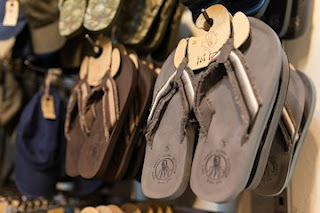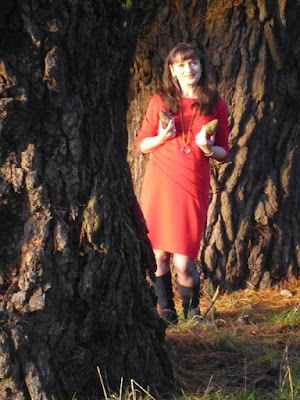Belatedly, I would like to
congratulate whoever was tasked with marketing the Fat Face brand. Whoever they are, they’re worth every penny of
their undoubted 6-figure salary.
To start with, we have a truly awful
name for a clothing line, with the kind of negative connotations of jeering,
playground catcalling ridicule that overweight people battle all their lives.
Then we have the clothes
themselves, which, at least in the early days, were quite amazingly dull. As
the new kid on the block some 25 years ago, fashion mags were full of Fat Face features in the late 1980s. Winsome
young people were pictured standing about against outdoorsy backdrops in limp attire
with the shagged-out look of a hundred muddy music festivals, and just as many
hot wash and spin cycles. The girls wore dresses and skirts in stagnant pond
colours, whilst the boys leaned on their hips in devoid-of-personality hoodie
tops, and jeans that had no more individuality than any other brand, and both
sported bags, boots, and other accessories that had equally little new or
special to say.
 |
| Fat Face flip-flops. The ultimate in slob chic |
The founders’ original (ground-breaking)
idea of a range of sweatshirts in which to go yomping about in the French Alps were
faithfully presented in tee-shirt cotton of muted browns, greens and blues that
might just as well have been passed down by an ageing ex-hippy parent who’d put
them in the recycling after years of faithful use in the garden digging the vegetable patch.
The best achievement for Fat Face was the price of this stuff: £extortionate.
What’s more, they somehow convinced people to pay for it. In droves.
Young shoppers clamoured to pay
for this dreary, overpriced clothing in their millions, and Fat Face after Fat Face opened up the length and breadth of the land.
But Fat Face just happens to be the first of many such lines that have
sprung up in this depressing vein.
‘Crew’ offer a nautical slant to more or less the same model, and
charge even more for their clothing. Fork out for one of their £40 stripey tee
shirts, pull your hair into a ponytail, add a blazer, and Robert is your father’s
brother - you’re the Duchess of Cambridge at a charity Volley Ball match.
Then you have ‘The White Company’. With a suitably
ostentatiously underplayed (tasteful) name and presentation, they too offer
uninspiring wool and cotton draperies for silly money. Catalogues stuffed into
upmarket magazines convince the Yummy Mummy brigade that a draggy jumper devoid
of all feature but for its label and £80+ price tag is the absolute must-have
for the school run.
But for Joe Brown’s who present a fabulously quirky and timeless range for
reasonable prices, fashion really seems to have lost its way.
 |
| A typically untypical Joe Brown's coat. |
Spending as much time as I do
attending charity 1940s events, I have come to mourn the loss of style and
tailoring in what passes for modern fashion. Surrounded by nipped-in waists,
tailoring, hairstyles, and dapper gents, I am minded of earlier times when
couturiers studied and followed the shape of the human body, draping their
textiles to flatter and enhance it.
The last war of course, was the
ultimate time of austerity, and ‘Fashion on the Ration’. Even the Queen had to
use coupons to get the fabric for her wedding dress - well, at least for the
sake of appearances… (with a handful of other residences to which they could retreat,
her mother had set the pace by pretending that a bit of bomb damage to one wing
of Buckingham Palace somehow set the Royals on a par with the flattening of the
East End and the homelessness that ensued).
 |
| This kind of chic was everyday style for women of the 1940s. |
The ‘Utility’ label, so hated at
the time, has come to mean quality, style, and durability, the like of which
has rarely been seen since. If you can find anything with a CC41 label in it
now, and are underfed enough to fit into it, you’ll still look like a £million.
It’s no wonder there is a growing army of semi-professional 1940s reenactors
who spend their lives recreating this look, even to the extent of fitting out
their homes in 1940s style.
 |
| The reviled CC41 Utility label... |
 |
| ...and the sort of garment in which you would find one. A CC41 Utility red wool coat - circa 1941 |
I recently went looking for a simple blue jersey dress with a three-quarter length sleeve to wear for job interviews and early evening outings. No chance. In nearly every store dress department I tried, I was assailed by rail after rail of hideous, splashy flower shower curtain prints on ghastly floor-sweeping maxi dresses (a trend that appears to have lasted several years now, instead of for just one, embarrassing season), or crass sleeveless mini dresses. Anything approaching the classics, and you’re talking big money.
I just received the Adini catalogue through the door. Some
years ago, in the days when their prices reflected their humble Carnaby Street Indian
Hippy Shop beginnings, I bought a flattering tunic top from them in a
gloriously muted watermelon pink. The top has been used as a nightdress for
some time, but I’ve been sent their catalogue every season since, just in case they
can tempt me to buy something else. Not likely, unless they drop the tiresome ‘delicate’
florals, and stop charging upwards of £50 for what amounts to a tee-shirt.
I was born in the 1960s. Dressed
exclusively at Biba as a toddler by my groovy mother, I became a punk at
school, then a mod, then a skin’ead, then a ‘Rude Girl’ in time for the ‘Two-Tone’
Rock against Racism years. I dressed in bold checks and block coloured shift
dresses with pointed shoes from Shelly’s.
As a young music journalist, I went to Antony Price Fashion shows at the Camden
Palace in the company of the late Paula Yates, and lived through the excitement
of Haysi Fantayzee, Boy George and Marilyn.
 |
| Antony Price 'Bronze Goddess' gown. Circa 1983 |
Then along came Madonna, with her
leather jackets and lace gloves, footless tights, miniskirts, and an old drum
case for a handbag. I was lucky enough to be one of the first British
journalists to interview her, and she inspired me to use an old vanity case as
a briefcase, which meant I had a mirror on the inside lid in which to check my
liquid liner every time I reached inside for my notebook.
Who do we have for inspiration
now? If you aspire to look like Wallis Simpson, Audrey Hepburn or Grace Kelly,
you’re a ‘vintage’ nut-job. We literally no longer seem to have any sort of style
identity. Look around. Can you tell what year this is just from people’s dress?
Mmm… not really.
‘Mmm… not really’ seems to sum up
fashion on the High Street. It’s all been done before. It’s the same old, same
old. Hoodies, fleeces, tee-shirts, flowery blouses, garish knitwear, jeans, parkas,
and droopy, drapey, ‘boyfriend’ cardis. Year after year. Only the colours
change. Slightly.
If you want to rock the classics
though, it’s still possible to achieve a smart-casual effortless chic look for not
much outlay, but you do have to go off-piste. By off-piste, I mean wearing dark
glasses and through the doors of such shops as the Edinburgh Woollen Mill.
I kid you not. Need a dress for a
smart garden party? You’ll find it there. Same goes for neat little jackets,
gloves and hats. I found a fabulous giraffe print stretch pencil skirt in there
last year. Every time I wore it, friends would exclaim: “where did you get that
amazing skirt?” When I told them, they refused to believe me.
 |
| The author in a £12 sale red jersey dress from Roman at M&Co - 2014 (pine cones: model's own...) |
In these faceless times, more
than ever, one needs to acquire the art of rummaging. Phase Eight do a classic little black dress with every season, but
you have to walk through to the back of their shops to find it, M&Co have teamed up with Roman who offer a handful of reasonably
priced classics, but they’re nestling on the rails in amongst some spangled frights
fit only for cruise ship Shirley Bassey impersonators.
“Everyone in this room is wearing
a uniform. Don’t kid yourself” said Frank Zappa in 1970.
Seems we still are. And a very
dull one it is too.
© Emmeline Wyndham - 2016